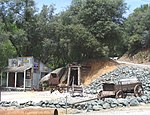Woolman Semester
The Woolman Semester was a semester school focused on the intersections of peace, social justice, and sustainability. The school operated from the Spring of 2004 through the Spring of 2016. Students came from all over the country to attend Woolman for a single semester during their high school junior, senior, or gap year. Students spent a semester deeply immersed in contemporary topics and exploring issues first hand . Students worked with each other, staff and interns to run the daily operations of the school, including cooking meals, chopping firewood, and growing and harvesting the food eaten at the school. The classes of the program were Global Thinking, Peace Studies, Environmental Science, Non-violent Communication, Ceramics, and Farm to Table. Woolman is the only Quaker (Friends) semester school in the country, and in accordance with the philosophy of Quaker Education the Woolman Semester curriculum centers around collaboration, activism, and open inquiry into local and global issues.
Excerpt from the Wikipedia article Woolman Semester (License: CC BY-SA 3.0, Authors).Woolman Semester
Woolman Lane,
Geographical coordinates (GPS) Address Nearby Places Show on map
Geographical coordinates (GPS)
| Latitude | Longitude |
|---|---|
| N 39.269702777778 ° | E -121.102325 ° |
Address
Woolman School
Woolman Lane
California, United States
Open on Google Maps




